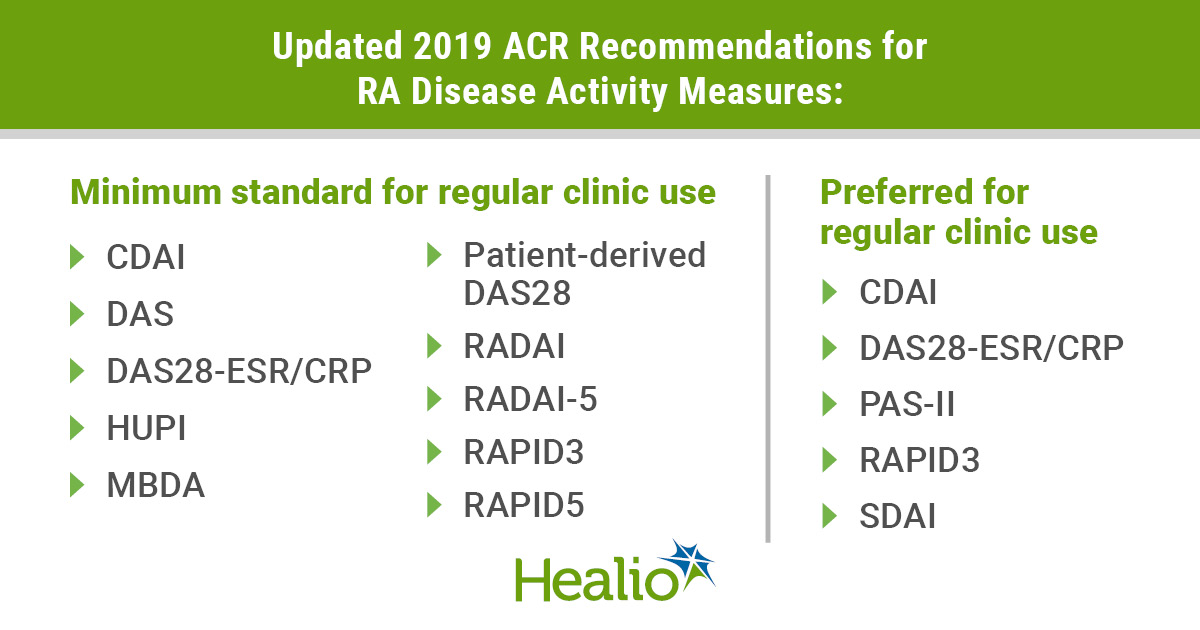ACR permits use of multibiomarker disease activity score in updated RA recommendations

The 2019 update of the American College of Rheumatology recommended rheumatoid arthritis disease activity measures now includes a stipulation to allow for use of the multibiomarker disease activity score, a key update from the previous iteration.
“The ACR put together a working group to provide the recommendations and draft the protocol for making recommendations,” Bryant England, MD, assistant professor in the division of rheumatology and immunology at the University of Nebraska Medical Center, told Healio Rheumatology. “We started by conducting a systematic literature review of RA disease activity measures since the time of the last recommendations.”
England and colleagues identified 5,199 articles pertaining to RA disease activity measures, and ultimately included 110 in the final review. The researchers then assessed the performance of these measures using a scoring tool and their feasibility for regular use in the clinic.
“Finally, we performed a modified Delphi process to provide the recommendations on measures that met a minimum standard as well as preferred RA disease activity measures for regular use,” England said.

Forty-six potential RA disease activity measures underwent analysis, including measures for patient, provider, laboratory and/or imaging data, according to the findings. Ultimately, the researchers recommended five disease activity measures for regular use in clinical practice: DAS28 with Erythrocyte Sedimentation Rate (ESR) or C-reactive protein (CRP); Clinical Disease Activity Index (CDAI); Simplified Disease Activity Index (SDAI); Routine Assessment of Patient Index Data (RAPID) 3 and; Patient Activity Scale (PAS) II.
“Five of the six previously recommended RA disease activity measures were again recommended,” England said. “The performance of these measures is well understood, they have been integrated into clinical settings widely, and they continue to be the focus of many research studies.”
The other measures that did not make the cut for use in regular clinical practice, but did meet minimum standards for regular use include the RAPID 5; the Hospital Universitario La Princesa Index (HUPI), MBDA score, Rheumatoid Arthritis Disease Activity Index (RADAI) and RADAI-5.
England noted that the selection of all of these measures offers clinicians latitude to inform clinical decision-making. “To provide clinicians with more options, we also provided a list of measures that met our minimum standard for regular use,” he said. “Reasons these were not selected as preferred measures include less clarity on their performance and not being as feasible for regular use.”
Perhaps the most striking addition to the recommendations is for the MBDA. “This disease activity measure provides an overall score from 0 to 100 based on the values of 12 serum biomarkers,” England said. “Based on its performance characteristics and feasibility, it fulfilled the minimum standards for regular use. However, the MBDA was not selected as a preferred RA disease activity measure for regular use.”
The researchers recognized that many providers may have attachments to certain measures, according to England.
“This attachment can be based on familiarity with its use and performance, or because the provider’s practice setting may work best with a certain RA disease activity measure,” he said. “This is why we established the minimum standard for RA disease activity measures for regular use and identified the measures that met this standard. While providers are free to choose the measure that works best in their practice, we recommend selecting a preferred measure if they are looking for a RA disease activity measure to use in their practice.” – by Rob Volansky
Disclosure: England reports no relevant financial disclosures.

